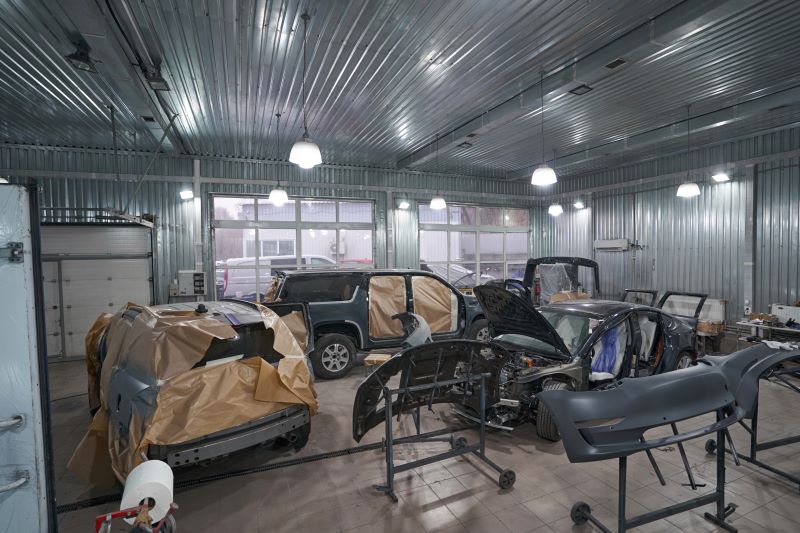The fusion of industrial artistry and interior design is a unique and innovative exploration, where the unlikely environment of auto body shops plays a significant role. More than just a place for car repairs and modifications, these workshops are treasure troves of inspiration and unconventional materials – from auto parts to specialized tools and automotive paint. These elements, when creatively repurposed, can introduce a distinctive edge to interior spaces that breaks from the norm. The exciting interplay of the ruggedness of auto body shops with the finesse of interior design promises a compelling discourse on the revolution of space design that you wouldn’t want to miss.
Key Takeaways
– Auto body shops have a unique and innovative approach to interior design, using unconventional materials and repurposed tools.
– Incorporating automotive paint into interior spaces can inject bold and vibrant colors, adding a luxurious touch.
– Repurposing auto shop tools, such as car parts and license plates, can create striking and functional furniture and decor.
– The collision of concepts in auto body shops leads to impressive innovations in interior design, expanding creative horizons and promoting sustainability.
Unconventional Materials: Car Parts
Venturing into the realm of unconventional materials, auto body shops are now ingeniously repurposing car parts to create unique and dynamic interior designs. This innovative approach has opened a world of possibilities, with ‘Engine Component Artistry’ and ‘Tire Furniture Concepts’ becoming popular trends.
Engine Component Artistry primarily involves the transformation of engine parts into exquisite pieces of artwork. Old pistons, gears, and valves are breathed new life into, metamorphosing into impressive sculptures or chic, industrial-style light fixtures. These creations are not only aesthetically appealing but also embody a commendable eco-friendly ethos, ensuring these components don’t end up in a landfill.
On the other hand, Tire Furniture Concepts take the humble tire and elevate it into functional and stylish furniture. From ottomans and coffee tables to innovative garden planters, these tire transformations showcase a perfect blend of creativity and sustainability.
Both these trends highlight the innovative spirit of Auto Body Shop, redefining what interior design can entail. By embracing these unconventional materials, they are setting new design standards while promoting sustainability in a unique, inventive manner.
Automotive Paint in Interior Design
Harnessing the vibrant spectrum and durable quality of automotive paints, interior design has embraced this medium to inject bold, statement-making colors into spaces, elevating the aesthetics to an unprecedented level. This revolution is driven by the exploration of Automotive Color Trends and innovative Paint Application Techniques borrowed from auto body shops.
Auto body shops, traditionally focused on exterior vehicle aesthetics, are now contributing significantly to interior design through:
* **Automotive Color Trends**
* *Bold and Vibrant*: Auto paints offer a wide array of bold, vibrant colors. This array transcends traditional interior paint options, providing interior designers with a new palette for creating stunning visual impacts.
* *Metallic and Pearlescent Finishes*: These trends offer a unique shimmer and depth of color, adding a luxurious touch to any interior space.
* **Paint Application Techniques**
* *Spray Painting*: This technique provides a smooth, seamless finish, allowing for the creation of a flawless aesthetic in interior spaces.
* *Color Sanding and Buffing*: These techniques result in a high-gloss finish, enhancing the depth and richness of color, while providing a durable surface that withstands the rigors of daily life.
Incorporating automotive paint into interior design represents an innovative, detail-oriented, and creative approach to reimagining spaces.
Repurposing Auto Body Shop Tools
In an intriguing twist of innovation, tools traditionally used in auto body shops are finding their way into the realm of interior design, serving as repurposed elements that enhance aesthetic appeal and functional utility. This trend is defined by the transformative potential of retired tools, where Tool Transformation Ideas are becoming a key concept in Harnessing Industrial Aesthetics.
Spanners and wrenches can be welded together to create unique, robust wall art or converted into distinctive door handles, bringing an edgy, industrial touch to a space. Salvaged car parts, such as gears or pistons, can be transformed into striking table bases or lamp stands, while old license plates can be cleverly converted into innovative wall coverings or curtain blinds.
This trend is not just about recycling, but also about celebrating the beauty of age, wear, and functionality. Each tool carries a history, an authenticity that adds depth and character to the design aesthetics.
Innovation From Collision to Creation
Often, the most impressive innovations in interior design arise from the collision of concepts, as seen in the creative transformation of auto body shop tools into decorative home features. This fusion, dubbed ‘Innovation from Collision to Creation’, underlines the innovation influence that these unconventional materials can exert on home aesthetics.
The transformation process can be categorized into two levels of innovation:
– **Macro-Level Innovation:**
– Collision creativity is evident in the large scale repurposing of auto body shop tools. For example, car ramps can be innovatively used as bookshelves, while hood and trunk lids can morph into stylish coffee tables.
– **Micro-Level Innovation:**
– On a smaller scale, auto parts like gears, nuts, and bolts can be creatively assembled into intricate pieces of wall art or table accessories, demonstrating how the innovation influence permeates every aspect of interior design.
The art of transforming something ordinary into extraordinary lies at the heart of interior design. By venturing into the realm of auto body shops for inspiration, designers are not only expanding their creative horizons but also promoting sustainability through the creative reuse of materials.
Conclusion
In summary, the innovative fusion of auto body shop materials and techniques with interior design has opened up a new realm of aesthetic possibilities. The utilization of automotive paint, repurposed auto shop tools, and even car parts in interior designs, as seen in the hypothetical case of a loft space converted with auto elements, challenges conventional design norms while offering unique, functional, and visually striking spaces. This underscores the potential of cross-industry collaboration in sparking creativity and innovation.
